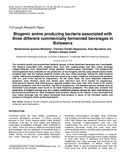Biogenic amine producing bacteria associated with three different commercially fermented beverages in Botswana

View/
Date
2013Author
Matsheka, Maitshwarelo Ignatius
Magwamba, Clement Chedza
Mpuchane, Sisai
Gashe, Berhanu Abegaz
Publisher
Academic Journals, http://www.academicjournals.org/AJMRRights holder
Copyright 2013 Academic JournalsType
Published ArticleMetadata
Show full item recordAbstract
The microbial quality and predominant bacterial groups of three fermented beverages was investigated.
The bacteria associated with sorghum beer, sour milk (madila/amasi) and sour maize beverage
(mageu/mahewu) were determined using standard microbiological techniques. The predominant
microorganisms were screened for the production of four biogenic amines using decarboxylase broth.
Sorghum beer had the highest bacterial counts with sour maize beverage having the least bacterial
counts. Hafnia alvei isolated from sour milk was found to be a major histamine and putrescine producer
with 21.2 and 17.56 mg/100 ml respectively. On the other hand, the most important cadaverine
producers were Pantoea citrea and Hafnia alvei with19.27 and 18.75 mg/100 ml respectively.
Enterococcus faecium and Enterococcus faecalis isolated from sour milk were found to be prolific
tyramine producers with 35.5 and 20.07 mg/100 ml respectively. The Bacillus species isolated from all
fermented food products were found to be weak histamine producers. The study also revealed that
production of biogenic amines was not a widely distributed property among the lactic acid bacteria as
previously documented for other fermented food products. Based on the results, it was concluded that
sour maize beverage was the safest fermented food product in terms of the microbial quality and
presence of biogenic amine producing bacteria.
